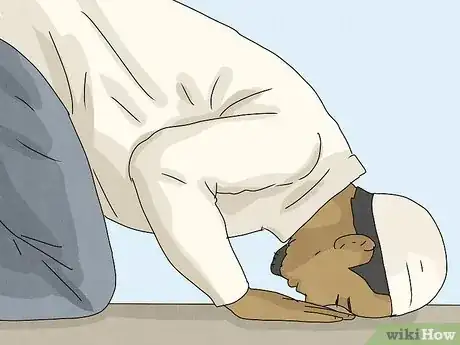This article was co-authored by wikiHow staff writer, Nihal Shetty. Nihal Shetty is a Writer and Editing Fellow at wikiHow who splits his time between Michigan and Mexico City. Before his role at wikiHow, he was an instructor of Russian literature at the University of California, Berkeley. Nihal received a BA in Comparative Literature from Columbia University and an MA in Russian at Berkeley.
There are 10 references cited in this article, which can be found at the bottom of the page.
This article has been viewed 34,040 times.
Learn more...
Learning more about Islam and interested in praying Asr? This is a great decision—as one of the obligatory 5 daily prayers of Islam, Asr is performed by Muslims across the globe. By learning how to perform this prayer, you’ll grow closer to Allah and the Muslim community at large. Here’s our complete guide on how to pray Asr.
Steps
How to Pray Asr
-
1Make an intention to pray. Think about the prayer you intend to perform, and mentally note your intention to perform it. You can do this in English or whichever language you’d like. For instance, you might say something in your mind like:[10]
- “I intend to pray 4 rakat for Asr today.”
-
2Enter Qiyam and say the Takbir. Qiyam is a standing position, during which you stand with your hands folded in front of you. From this position, raise your hands up to your ears and say the Takbir: “Allahu akbar” (“God is great”). After you say the Takbir, lower your hands again.[11]
-
3Recite the opening supplication (optional). Many people perform a short dua (supplication) after this prayer, which is sunnah, meaning that the prophet (PBUH) practiced this, but it is not obligatory. If you’d like to recite this dua, you can say the following:[12]
- “Subhanaka Allahumma wa bihamdika wa tabarakasmuka, wa ta’ala jadduka wa la ilaha ghairuk”
- Meaning: “Glorious You are O Allah, and with Your praise, and blessed is Your Name, and exalted is Your majesty, and none has the right to be worshipped but You.”
-
4Begin the first rakat by reciting Surah al-Fatiha. Each rakat begins with the recitation of Surah al-Fatiha, the first chapter of the Quran. After reciting this chapter, it’s conventional to say “Ameen.” Surah al-Fatiha goes as follows:[13]
- “Bismillaahir Rahmaanir Raheem Alhamdu lillaahi Rabbil ‘aalameen Ar-Rahmaanir-Raheem Maaliki Yawmid-Deen Iyyaaka na’budu wa lyyaaka nasta’een Ihdinas-Siraatal-Mustaqeem Siraatal-lazeena an’amta ‘alaihim ghayril-maghdoobi ‘alaihim wa lad-daaalleen”
- Meaning: “With the name of Allah, the All-Merciful, the Very-Merciful. Praise belongs to Allah, the Lord of all the worlds, the All-Merciful, the Very Merciful. the Master of the Day of Requital. You alone do we worship, and from You alone do we seek help. Take us on the straight path, the path of those on whom You have bestowed Your Grace, not of those who have incurred Your wrath, nor of those who have gone astray.”
-
5Recite another section of the Quran. For your first two rakat, select another part of the Quran to recite after Surah al-Fatiha. You can choose any section of the Quran, but if you’re just beginning, one common selection is Surah Ikhlas, which goes as follows:[14]
- “Bismillah hir Rahman nir Rahim Qul Huwallahu ahad. Allahussamad. Lam yalid wa lam yu-lad. Wa lam yakun lahu kufuwan ahad.”
- Meaning: “In the name of Allah, the most Gracious, the most Merciful. Say, He is Allah, the One. Allah is Eternal and Absolute. He begets not, nor was He begotten. And there is none co-equal unto Him.”
-
6Enter Ruk’u and offer praise to Allah. Ruk’u is a bowing position, where you lean forward with your legs still straight. Move into this position by placing your torso almost parallel to the ground, and your hands on your knees. As you move into this position, say “Allahu Akbar,” then once you’re in Ruk’u, repeat the following prayer 3 times:[15]
- “Subhaana rabbiyal ‘atheem”
- Meaning: “Glory be to my Lord, the Supreme.”
-
7Return to Qiyam. Rise back into the standing position. As you do so, say the following words: “Sami’-Allahu liman hamidah” (“Allah listens to the one who praises Him.”). When you’re standing upright again, say, “Rabbana wa lakal hamd” (Our Lord, and to You belongs the praise.”).[16]
-
8Enter Sujood. Sujood is a position during which you’ll be prostrating. Lower yourself to the ground, with your knees, nose, and forehead touching the floor. Place your palms on the floor as well, beside your head. As you lower yourself into Sujood, say “Allahu Akbar.” Then, when you’re in Sujood, repeat the following 3 times:[17]
- “Subhaana rabbiyal ‘alaa.”
- Meaning: “Glory be to my Lord Most High.”
-
9Rise into Juloos. Juloos is the sitting position. Sit on your knees, with your legs parallel with one another. Place the weight of your body on your left thigh. The toes of your right foot should be facing the Qiblah, and your hands should be placed on your knees. As you enter Juloos, say “Allahu Akbar.” Then, when you’re in the sitting position, repeat the following 3 times:
- “Rabbighfirlee”
- Meaning: “O Allah, forgive me.”
-
10Enter Sujood again to complete the first rakat. Return to the prostration position, with your forehead and nose touching the floor. As you do so, say “Allahu Akbar.” When you’re in sujood, repeat the following three times in order to complete your first rakat:
- “Subhaana rabbiyal ‘alaa.”
- Meaning: “Glory be to my Lord Most High.”
-
11Repeat the first rakat as part of the second rakat. The steps of the second rakat are identical to the first rakat, just with the addition of the Tashahud at the end. Rise into Qiyam, then begin your second rakat from the recitation of Surah al-Fatiha.
-
12Recite the Tashahud. At the end of the second rakat, rise from Sujood back into Juloos, the sitting position. In this position, you’ll recite the Tashahud, which goes as follows:[18]
- “At-tahiy-yatu lil-lahi was-salawatu wat-taiyibatu . Assalamu 'Alaika aiyuhan-Nabiyu wa-rahmatul-lahi wa-barakatuhu. Assalamu alai-na wa-'ala i-ba-dil-lahis-sali-hin. Ash-hadu al-la ilaha il-lal-lahu wa ash-hadu an-na Muhammadan 'abdu hu wa Rasuluh.”
- Meaning: “All the compliments are for Allah and all the prayers and all the good things (are for Allah). Peace be on you, O Prophet, and Allah's mercy and blessings (are on you). And peace be on us and on the good (pious) worshipers of Allah. I testify that none has the right to be worshipped but Allah and that Muhammad is His slave and Apostle.”
-
13Perform the third rakat. After finishing the Tashahud, return to Qiyam to begin the third rakat, starting from the recitation of Surah al-Fatiha. Keep in mind that you do not need to recite an extra Surah after Fatiha during the third rakat. The third rakat is otherwise identical to the first rakat.[19]
-
14Perform the fourth rakat. After finishing the third rakat, rise from Sujood back into Qiyam. Begin this rakat from the recitation of Surah al-Fatiha. Like the third rakat, you do not need to recite an additional Surah after this. The fourth rakat is otherwise identical to the second rakat, including the recitation of the Tashahud afterwards.[20]
-
15Recite the Tashahud. Just as you did after the second rakat, following the fourth (and final rakat), say the Tashahud while sitting in the Juloos position. The Tashahud goes as follows:[21]
- “At-tahiy-yatu lil-lahi was-salawatu wat-taiyibatu . Assalamu 'Alaika aiyuhan-Nabiyu wa-rahmatul-lahi wa-barakatuhu. Assalamu alai-na wa-'ala i-ba-dil-lahis-sali-hin. Ash-hadu al-la ilaha il-lal-lahu wa ash-hadu an-na Muhammadan 'abdu hu wa Rasuluh.”
- Meaning: “All the compliments are for Allah and all the prayers and all the good things (are for Allah). Peace be on you, O Prophet, and Allah's mercy and blessings (are on you). And peace be on us and on the good (pious) worshipers of Allah. I testify that none has the right to be worshipped but Allah and that Muhammad is His slave and Apostle.”
-
16End the prayer with Taslim. After completing the four rakats, you’re ready to end the prayer. While sitting in Juloos, turn your head to the right and say “Assalamu alaikum wa rahmatullah” (“May the peace and mercy of Allah be upon you”). Then, turn your head to the left and repeat the phrase. The Asr prayer is now complete.[22]
References
- ↑ https://muslimversity.com/how-many-times-a-day-do-muslims-pray/
- ↑ https://muslimversity.com/how-many-times-a-day-do-muslims-pray/#What_times_do_Muslims_pray
- ↑ https://islamqa.info/en/answers/111783/how-can-he-make-up-for-missed-prayers
- ↑ https://www.tenfold.ngo/wp-content/uploads/2019/06/TF-A5SalahBooklet-R3a-1.pdf
- ↑ https://theislamicworkplace.com/disability-and-islam/
- ↑ https://muslimversity.com/how-many-times-a-day-do-muslims-pray/
- ↑ https://www.iium.edu.my/deed/lawbase/risalah_maliki/book02.html
- ↑ https://www.tenfold.ngo/wp-content/uploads/2019/06/TF-A5SalahBooklet-R3a-1.pdf
- ↑ https://www.tenfold.ngo/wp-content/uploads/2019/06/TF-A5SalahBooklet-R3a-1.pdf
- ↑ https://www.tenfold.ngo/wp-content/uploads/2019/06/TF-A5SalahBooklet-R3a-1.pdf
- ↑ https://myislam.org/how-to-pray-salah/
- ↑ https://myislam.org/opening-dua-of-salah/
- ↑ https://allonlineislam.com/surah-fatiha-translation/
- ↑ https://myislam.org/how-to-pray-salah/
- ↑ https://www.tenfold.ngo/wp-content/uploads/2019/06/TF-A5SalahBooklet-R3a-1.pdf
- ↑ https://www.tenfold.ngo/wp-content/uploads/2019/06/TF-A5SalahBooklet-R3a-1.pdf
- ↑ https://www.tenfold.ngo/wp-content/uploads/2019/06/TF-A5SalahBooklet-R3a-1.pdf
- ↑ https://www.duasrevival.com/basics/way-of-life/tashahud
- ↑ https://myislam.org/how-to-pray-salah/
- ↑ https://myislam.org/how-to-pray-salah/
- ↑ https://www.duasrevival.com/basics/way-of-life/tashahud
- ↑ https://myislam.org/how-to-pray-salah/


















































































